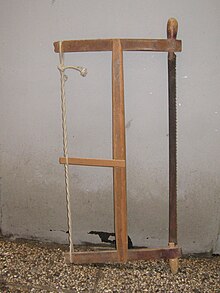| This is currently being merged. After a discussion, consensus to merge this with content from Bucksaw was found. You can help implement the merge by following the instructions at Help:Merging and the resolution on the discussion. Process started in August 2023. |


A modern bow saw is a metal-framed crosscut saw in the shape of a bow with a coarse wide blade. This type of saw is also known as a Swede saw, bushman saw, Finn saw or bucksaw. It is a rough tool that can be used for cross-cutting branches or firewood, up to a log diameter of half the blade length, limited by the height of the frame above the blade. Bow saws are typically available with blades of 320mm, 535mm, 610mm, 750mm or 950mm lengths (14, 21, 24, 30 or 36 inches). The name 'Swede saw' probably derived from the ovate metal tubular frame version, invented in the 1920s by the Swedish company Sandvikens Jernverk, and additional patents by two Swedish immigrants to the US. Modern versions all share those common features.
Traditionally, a bow saw is a woodworking tool used for straight or curved cuts. A bow saw is a type of frame saw. Its thin blade is held in tension by a frame. In English and American vocabulary it denotes a toothed blade suspended between two long narrow handles called "cheeks" that are supported and separated by a thin stretcher in the center of the handles, making a wide H shape (the cheeks form the uprights of the H, the stretcher the crossbar of the H). The blade is kept in tension with a turnbuckle or a twisted cord that runs parallel to the blade between the two cheeks but on the opposite side of the stretcher. If a cord is used, the cord is twisted with a toggle attached to one loop of the cord, adding tension. The toggle hits the stretcher, which keeps the cord from untwisting. A finer version of the saw uses a narrow blade of a 1⁄4 inch (6 mm) or less, with handles that allow the user to hold the saw and turn the blade. In this context it is also known as a turning saw, which is larger than a coping or fret saw.
The bow saw was used both in ancient China and the Hellenistic period, and developed from earlier saws.
The term 'bow saw' has also been applied to a type of chainsaw with a large, circular guide bar.
See also
References
- Sorden, L. G.. Lumberjack lingo,. 1st ed. Spring Green, Wis.: Wisconsin House, 1969. 14.
- Wood, Harry Einsley, and James Henry Smith. Prevocational and industrial arts,. Chicago: Atkinson, Mentzer & company, 1919. 9. Print.
- Joseph Needham (2 January 1965). Science and Civilisation in China: Volume 4, Physics and Physical Technology, Part 2, Mechanical Engineering. Cambridge University Press. p. 54. ISBN 978-0-521-05803-2.
In China, the saw achieved many subtle developments and a common form of it is the bow-saw... bow-saws were of course used also in Hellenistic times
External links
- A tool company's article on bow saw design
- DIY bow saw design
- A 1920s bow saw design Archived 2018-09-18 at the Wayback Machine
- A bushcraft bow saw tutorial
- American Bucksaws Reference Publications
- U.S. patent 1,411,590, Bow Saw
| Forestry tools and equipment | ||
|---|---|---|
| Tree planting, afforestation |
|  |
| Mensuration | ||
| Fire suppression | ||
| Axes |
| |
| Saws | ||
| Logging | ||
| Other | ||
| ||
| Lumberjack sports | ||
|---|---|---|
| Events |
|  |
| Competitions | ||